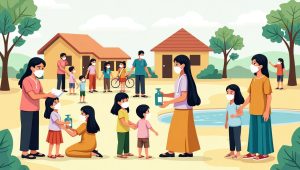
Human Metapneumovirus (HMPV) is a respiratory virus that poses a significant threat to vulnerable populations worldwide. In Indonesia, where healthcare disparities and environmental factors exacerbate the spread of infectious diseases, HMPV has become an emerging concern. This article explores how HMPV affects Indonesia’s most at-risk groups and what can be done to protect them.
Understanding HMPV
HMPV belongs to the Paramyxoviridae family and causes respiratory illnesses ranging from mild cold-like symptoms to severe conditions such as bronchiolitis and pneumonia. It spreads through respiratory droplets, direct contact with infected individuals, and contaminated surfaces. While most healthy individuals recover without complications, certain populations are more susceptible to severe outcomes.
Who Are the Vulnerable Populations?
1. Children
- High Risk: Children under five are particularly vulnerable to HMPV due to their developing immune systems. In Indonesia, where respiratory infections are a leading cHow HMPV Affects Indonesia’s Vulnerable Populationsause of childhood morbidity, HMPV adds to the burden.
- Impact: Severe cases can lead to hospitalization, especially in infants. Symptoms such as wheezing and difficulty breathing are common.
2. Elderly Individuals
- High Risk: Older adults often have weaker immune systems and may suffer from chronic conditions like diabetes, heart disease, or chronic obstructive pulmonary disease (COPD).
- Impact: HMPV can exacerbate pre-existing health issues, leading to prolonged recovery times and increased risk of complications.
3. Immunocompromised Individuals
- High Risk: People with weakened immune systems, such as those undergoing chemotherapy, living with HIV, or receiving organ transplants, are highly susceptible to severe HMPV infections.
- Impact: For these individuals, even mild respiratory infections can escalate into life-threatening conditions.
4. Residents of Rural and Underserved Areas
- High Risk: Limited access to healthcare facilities and diagnostic tools in rural Indonesia increases the risk of underdiagnosis and delayed treatment.
- Impact: The lack of timely medical intervention can lead to worse outcomes for individuals in these areas.
Why HMPV is a Growing Concern in Indonesia
1. Healthcare Inequities
- Urban areas like Jakarta have better access to healthcare resources, while rural regions often lack essential infrastructure and trained medical personnel.
- These disparities make it challenging to diagnose and treat HMPV effectively across the country.
2. Environmental Factors
- Indonesia’s tropical climate, characterized by high humidity and frequent rainfall, creates ideal conditions for the spread of respiratory viruses like HMPV.
- Seasonal spikes in respiratory infections often overwhelm healthcare facilities.
3. Low Public Awareness
- Many Indonesians are unaware of HMPV and its symptoms, leading to delayed diagnosis and treatment. This lack of awareness allows the virus to spread unchecked, particularly among vulnerable populations.
Protecting Vulnerable Populations
1. Raising Awareness
- Public education campaigns can inform communities about HMPV, its symptoms, and prevention strategies.
2. Improving Access to Healthcare
- Strengthening healthcare infrastructure in rural areas is essential for early diagnosis and treatment of HMPV.
3. Promoting Hygiene Practices
- Encouraging handwashing, mask-wearing, and surface disinfection can significantly reduce the spread of HMPV.
4. Vaccination Research
- Supporting research into vaccines for HMPV can provide long-term protection for at-risk groups.
Conclusion
HMPV is a serious threat to Indonesia’s vulnerable populations, including children, the elderly, and those with weakened immune systems